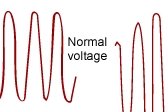
Interestingly, the position of your house relative to the main supply for your street can have an impact on your voltage supply – which may affect things like the lifespan of your lightbulbs.

What are voltage supply fluctuations?
A good analogy for voltage supply fluctuations can be made using your home’s plumbing. Consider this common situation: you’re enjoying a hot shower upstairs, and someone in the house turns on the hot water tap in the laundry downstairs. The shower turns cold – and you’re not happy!
Voltage fluctuations are similar. In simple terms, it’s the electrical equivalent of water pressure and when it goes low, there can be noticeable effects.
Voltage drops
Incandescent lamps, for example, rapidly lose brilliance when the voltage sags or dips, and are significantly affected by changes in voltage. Because they’re designed for a fairly specific voltage, small fluctuations can make a significant difference, and have a huge effect on things like a bulb’s lifespan. It used to be that some households, depending on their position relative to the pole transformer on their street, would need to replace their incandescent globes twice as often as their neighbours.
Fluorescent tubes are also affected, as are CFLs (compact fluorescent lamps). A 10% drop will probably not be visually noticeable, and generally a small drop is not likely to cause any short-term problems.
Electronic gear (TVs, etc.) have inbuilt voltage regulation – a tech term that refers to circuits inside this kind of hardware which keeps the voltage more or less constant.
If you’re in the country, voltage drop effects may be more dramatic. The reason for this is the presence of long power lines, which of themselves can ‘drop’ voltage during high power usage.
Voltage swells
Voltage increases above the nominal value can be destructive. In many cases, voltage swells will cause fuses or circuit breakers to pop, but generally you can’t rely alone on protection from MCBs (miniature circuit breakers) as they may not trip (disconnect the circuit) before damage is done. Voltage surges can occur because of instability in the electricity network.
Voltage surges
Unlike voltage swells, surges are sharp and can be several thousand volts for very short periods – these are particularly destructive. Surges are usually caused by lightning, but the source could be some large distance from your home. The voltages are often ‘induced’ – that is, they are not the result of a direct strike, but of a nearby strike.
How can voltage fluctuations be managed?
If voltage fluctuation is likely to be a problem (again the chances of this happening are small in capital cities), a voltage regulator may be the answer. This is a technical issue though, and in the first place your power supply company should be consulted if you’re having a problem. They should be able to place a voltage recorder in your premises so that they can gauge the size of the problem.
Voltage surges can be nasty. If you’re worried about them, talk to your electrical energy provider – don’t try to solve the situation simply by relying on a branded power distribution board for your computer and other precious gear.
Depending on lightning activity in your area, something called surge suppression may be needed at your switch box – as well as on incoming phone lines. The installation of this kind of hardware is a specialist area of knowledge, so get a professional to advise you.





